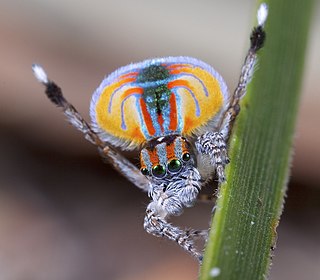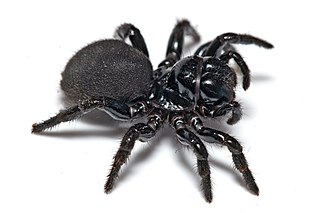
The hobo spider is a member of the genus of spiders known colloquially as funnel web spiders, but not to be confused with the Australian funnel-web spider. Individuals construct a funnel-shaped structure of silk sheeting and lie in wait at the small end of the funnel for prey insects to blunder onto their webs. Hobo spiders sometimes build their webs in or around human habitations. The hobo spider lays its eggs in September and they hatch during late spring. After the male hobo spider mates it dies.

Atracidae is a family of mygalomorph spiders, commonly known as Australian funnel-web spiders or atracids. It has been included as a subfamily of the Hexathelidae, but is now recognized as a separate family. All members of the family are native to Australia. Atracidae consists of three genera: Atrax, Hadronyche, and Illawarra, comprising 35 species. Some members of the family produce venom that is dangerous to humans, and bites by spiders of six of the species have caused severe injuries to victims. The bite of the Sydney funnel-web spider and northern tree-dwelling funnel-web spider are potentially deadly, but no fatalities have occurred since the introduction of modern first-aid techniques and antivenom.

Huntsman spiders, members of the family Sparassidae, are known by this name because of their speed and mode of hunting. They are also called giant crab spiders because of their size and appearance. Larger species sometimes are referred to as wood spiders, because of their preference for woody places. In southern Africa the genus Palystes are known as rain spiders or lizard-eating spiders. Commonly they are confused with baboon spiders from the Mygalomorphae infraorder, which are not closely related.

The redback spider, also known as the Australian black widow, is a species of highly venomous spider believed to originate in South Australia or adjacent Western Australian deserts, but now found throughout Australia, Southeast Asia and New Zealand, with colonies elsewhere outside Australia. It is a member of the cosmopolitan genus Latrodectus, the widow spiders. The adult female is easily recognised by her spherical black body with a prominent red stripe on the upper side of her abdomen and an hourglass-shaped red/orange streak on the underside. Females usually have a body length of about 10 millimetres (0.4 in), while the male is much smaller, being only 3–4 mm (0.12–0.16 in) long.

The Sydney funnel-web spider is a species of venomous mygalomorph spider native to eastern Australia, usually found within a 100 km (62 mi) radius of Sydney. It is a member of a group of spiders known as Australian funnel-web spiders. Its bite is capable of causing serious illness or death in humans if left untreated.

A spider bite, also known as arachnidism, is an injury resulting from the bite of a spider. The effects of most bites are not serious. Most bites result in mild symptoms around the area of the bite. Rarely they may produce a necrotic skin wound or severe pain.

Actinopodidae is a family of mygalomorph spiders found in Australia and South America. It includes mouse spiders, whose bites, though rare, are considered medically significant and potentially dangerous.

Missulena is a genus of mygalomorph spiders in the family Actinopodidae, sometimes called mouse spiders. It was first described by Charles Athanase Walckenaer in 1805. M. tussulena is found in Chile, but the rest are indigenous to Australia.

Maratus is a spider genus of the family Salticidae. These spiders are commonly referred to as peacock spiders due to the males' colorful and usually iridescent patterns on the upper surface of the abdomen often enhanced with lateral flaps or bristles, which they display during courtship. Females lack these bright colors, being cryptic in appearance. In at least one species, Maratus vespertilio, the expansion of the flaps also occurs during ritualised contests between males. The male display and courtship dance are complex, involving visual and vibratory signals.
Plesiolena is a small genus of mygalomorph spiders in the family Actinopodidae, first described by Pablo A. Goloboff & Norman I. Platnick in 1987. The name is a combination of "plesiomorphy" and the genus Missulena. As of March 2019, it contains two species.

Missulena occatoria, known as the red-headed mouse spider, is found in Southern Australia, from open forest to desert shrubland. It is the largest and most widely distributed Missulena species, because the spiderlings are wind-dispersed (ballooning). Normally this only occurs with araneomorph spiders, mygalomorph spiders normally disperse by walking. Missulena venom may be very toxic, but few cases of serious envenomation have been recorded. Most recorded bites only caused minor effects, with Australian funnel-web spider antivenom having proved effective as a treatment.

Australia has a number of highly venomous spiders, including the Sydney Funnel-web, its relatives in the family Hexathelidae, and the Redback Spider, whose bites can be extremely painful and have historically been linked with deaths in medical records. Most Australian spiders do not have venom that is considered to be dangerously toxic. No deaths caused by spider bites in Australia have been substantiated by a coronial inquest since 1979. There are sensationalised news reports regarding Australian spiders that fail to cite evidence. A Field Guide to Spiders of Australia published by CSIRO Publishing in 2017 featuring around 836 species illustrated with photographs of live animals, around 381 genera and 78 families, introduced significant updates to taxonomy from Ramirez, Wheeler and Dmitrov

Missulena bradleyi, also known as the eastern mouse spider, is a species of spider belonging to the family Actinopodidae. The spider is endemic to the eastern coast of Australia.
Missulena insignis, commonly known as the lesser red-headed mouse spider, is a species of spider belonging to the family Actinopodidae native to Australia. The species name is derived from the Latin insignis "mark".
Missulena pruinosa, commonly known as the northern mouse spider, is a species of spider belonging to the family Actinopodidae, native to Australia.
Michael Gordon Rix is an Australian arachnologist, whose publications mainly concern spiders.

Barbara Anne York Main was an Australian arachnologist and adjunct professor at the University of Western Australia. The author of four books and over 90 research papers, Main is recognised for her prolific work in establishing taxonomy for arachnids, personally describing 34 species and seven new genera. The BBC and ABC produced a film about her work, Lady of the Spiders, in 1981.

Henry Houghton Burton Bradley was an Australian arachnologist. He published papers on many types of spiders, in particular describing specimens found on the Chevert Expedition of 1875. Bradley corresponded with spider specialists in Europe and sent them collections.












